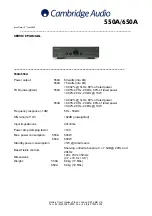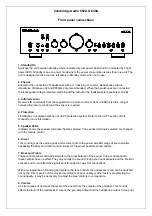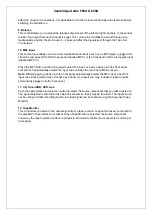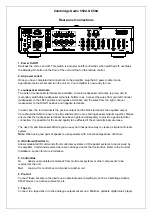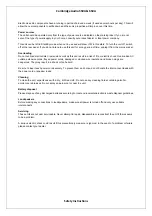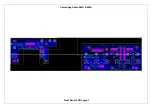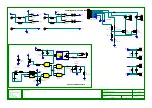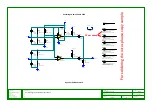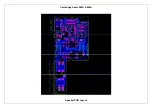
Cambridge Audio 550A & 650A
or CD recorder using an interconnect cable from the recorder's Line Out sockets to the amplifier's
Tape In sockets.
The Tape Input circuit of the 550A/650A is a ‘monitor’ type, different from the other five inputs. For the
five normal inputs, the source selected for listening to will also be sent out of the Rec 1/Rec 2 outputs
for recording. The source currently being listened to and (optionally) recorded is then shown on the
front panel by a corresponding blue LED.
However, when the Tape Mon Input is selected the Tape Mon LED will also illuminate, indicating that
the Tape Monitor Input is now being listened to with a different source being sent out of the
Rec1/Rec2 outputs for recording. The recording source is shown by the first LED and can be changed
by pressing the other source buttons. To switch Tape Monitor off, simply press the Tape Mon button
again, toggling this function off.
This feature is most useful when using three-head analogue cassette decks which allow the signal
being recorded to be played back live off tape (via a third head) whilst it is simultaneously recorded. It
is then possible, by toggling the Tape Monitor input on and off, to compare directly in real time the
original and recorded signal so that adjustments to the recording parameters of the tape machine can
be made. (Consult the manual of your three-head analogue cassette deck for full details.)
8. Record Out 1/2
These two identical output sockets can be connected to a tape deck or to the analogue Record In
sockets on a MiniDisc or CD recorder.
9.
Aux, DVD, Tuner/DAB, CD, MP3
These inputs are suitable for any 'line level' source equipment such as DVD players, DAB or FM/AM
tuners, CD players, MP3 players, etc.
Note:
These inputs are for analogue audio signals only. They should not be connected to the digital
output of a CD player or any other digital device.
Connecting a turntable
If it is desired to connect a turntable without a built-in phono stage, an external phono stage such as
our 540P or 640P models should be used. Contact your Cambridge Audio dealer for more details.
Note:
A very few turntables have built-in phono stages, in which case it is not necessary to use a
separate phono stage amplifier. If you’re unsure, please consult your turntable user manual.
Connections
When designing our amplifiers we include features that allow you to connect your system in various
ways. The inclusion of features such as Pre-Out and Speaker B connections mean that you can
flexibly configure your system depending on your requirements.
Basic connection
The diagram below shows the basic connection of your amplifier to a CD player and a pair of
loudspeakers.
Summary of Contents for AZUR 550A
Page 13: ...550A 650A Exploded Diagram ...
Page 17: ...Cambridge Audio 550A 650A Front Panel PCB Layout ...
Page 21: ...Cambridge Audio 550A 650A Speaker PCB Layout ...
Page 25: ...Cambridge Audio 550A 650A Input PCB Layout ...
Page 31: ...Cambridge Audio 550A 650A Preamp PCB Layout ...
Page 34: ...Cambridge Audio 550A 650A Volume PCB Layout ...
Page 44: ...Cambridge Audio 550A 650A AMP Layout ...
Page 49: ...Cambridge Audio 550A 650A Mains PCB Layout ...
Page 52: ...Cambridge Audio 550A 650A Protection PCB Layout ...
Page 61: ...IC Pin Layouts for the Cambridge Audio Azur 550A 650A Amplifier LM393D U6 ...

